UNIT 5:TEAM LEADERSHIP
Key Unit Competence: To be able to demonstrate a good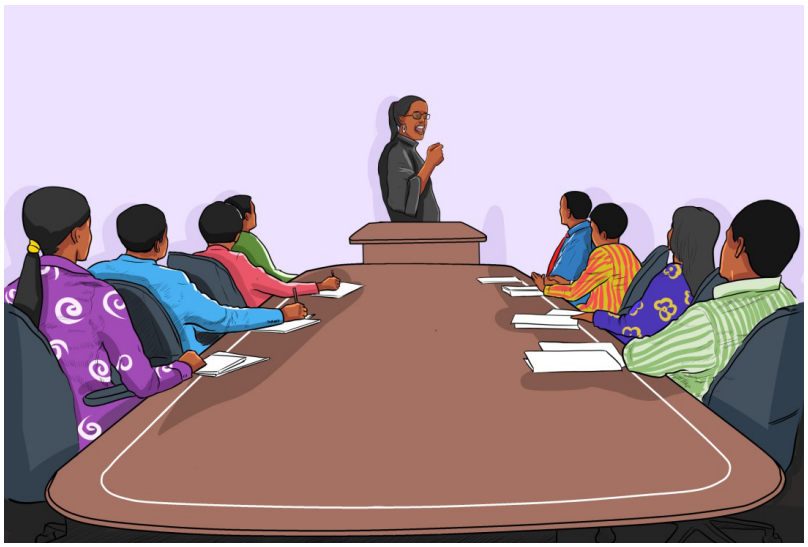
leadership strategy for leading teams in the business.
Introductory activity
There is no right or wrong way to answer this assessment.
It is for your own use during this unit.
You will read an element of competence listed in the left column.
Think about yourself: do you think you can do this?
How well? Read the statements across the top.
Put a check in column that best represents your situation.At the end of this unit, you will take this assessment again.

5.1 Meaning of leadership and Qualities of a leader
Activity 5.1
1. Read the following paragraph and answer questions that follow.
Think about a time when you have been a leader.
It can be a leader of anything, a group task at school,
home or in your community, at a job, being a leader on a sports team...
a. How did you like playing that role?
b. What made it difficult or easy for you?
c. Based on your experience described above,
what do you understand by leadership?
2. a) Referring to your community, or country, name any three (3)
examples of leaders who you think are inspiring
(famous people or people from your community).
b) Describe the characteristics/qualities you thinkmake those leaders inspiring or effective.
5.1.1 Meaning of leadership
Leadership is the art of motivating/ influencing
a group of people to act towards achieving a common goal.
This leadership definition captures the essentials of being able
to inspire others and being prepared to do so.
Effective leadership is based upon ideas
(whether original or borrowed),
but will not happen unless those ideas can be communicated
to others in a way that engages them enoughto act as the leader wants them to act.
Put even simpler, a leader is the inspiration and director of the action.
He or she is the person in the group that possesses the combination
of personality and leadership skills that makes otherswant to follow his or her direction.
5.1.2 Qualities of good leader
To help you improve your leadership skills,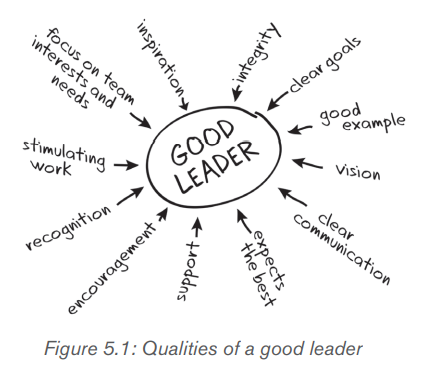
here are examples of what makes a great leader.
a. Determination
A great leader has a never-ending determination.
He/she is the first one to initiate an idea and the last one to give up.
It is because of a leader’s determinationthat projects are started and completed successfully.
b. Flexibility
A great leader can adapt to any situation.
He/she sees the situation from many differentangles and can adjust himself accordingly.
c. Resourcefulness
Generally, leaders do not always get what they want easily.
But since effective ones are creative, they think of ways
to get what they want. Besides, they collaborate with
the employees to fully utilize the available resourcesin achieving the organizational objectives.
d. Creativity
He/she is characterized by critical thinking coming up
with effective ways of doing things right that do not require a lot of time,effort or money but ending up successfully.
e. Self-confidence
People will follow a leader who believes in him or herself.
This does not mean being arrogant;rather, it means trusting in yourself and your abilities.
f. Positive Attitude / Optimism
A great leader has a positive outlook and triesto make the best out of everything.
g. Responsible
A great leader understands that whatever happens in his/her team
(whether good or bad) is his responsibility. He/she does not take
all the credit for work well done and does not blame others when there is failure.
h. Consistency / Reliability / Accountability
A great leader is dependable, always does his/her best,takes action and delivers good results.
i. Planning ahead
A good leader knows what is up ahead.
He has good judgment in predicting what may happenin the future and can make work decisions based on that.
j. Patience
A great leader is able to wait, to continue doing something
despite difficulties, or to suffer without complaining or
becoming annoyed.
Patience is enduring under difficult circumstances,
exhibiting endurance when under strain, especiallywhen faced with longer-term difficulties.
k. Being objective
A good leader does not take sides but is open to different opinions.
Personal feeling or opinions do not influence him/herin considering and representing facts.
l. Perceptive
A good leader has an awareness of the people s/he is leading.
He/she has intuitive, understands people he/she is leading
or situations and shows sensitivity Briefly, what makes a great leader
is a mix of these qualities and many more others.
A person does not necessarily need to possess all the qualitiesbut one should at least strive to develop many of them.
m. Intelligent
An effective leader should have the ability
to think and come out with original/ personal ideas and ability
to make proper decision which may help in solving business problems.
An effective leader is also good communicator, honesty, disciplined,exemplary as well as inspiring.
Application activity 5.1
Read the following extract from “Rwanda.
A remarkable turnaround of a nation, 2014, page 9)
and answer questions that follow:
To produce the desired outcomes, structural advantages have to interact with the agency
– social organization and leadership. Fortunately for GS RUGWIRO,
at the heart of its success has been focused on good leadership
to guide the institution through various reforms.
The head teacher and his colleagues have exhibited extraordinary
leadership values and skills aimed at navigating local difficulties
and external pressures to steer the institution to success.
Yet, its achievements are not singularly because of the intrinsic values
of its internal organization, the institution
– however, important these may be. Rather, they have largely
been because of institution’s ability to build a broad-based
collaborative relationship with other schools and social
wellbeing of staff in the school to sustain the momentum
for progressive change.
a. Do you describe GS RUGWIRO as a team?
Give reasons to support your response
b. From the extract, why do you think
GS RUGWIRO has a good leadership
c. Do you describe the head teacher of the above school
as an effective leader? Support your response withfour qualities from the extract.
5.2 Leadership styles
Activity 5.2
Analyze the Leadership styles below and answer questions that follow:
• The “Authoritarian” Leader/ Autocratic style/Authoritarian
• The “Persuading” leader:
• The “Consulting” Leader:
• The “Joining” Leader:• The transformative leader:
Required:
a. Explain the meaning of each leadership styles above
b. Think and give examples of people you know who
tend to lead or have led in each of the leadership style explained above.c. Describe when each leadership style would be appropriate to use
As a leader, it is important to understand the different styles of leading.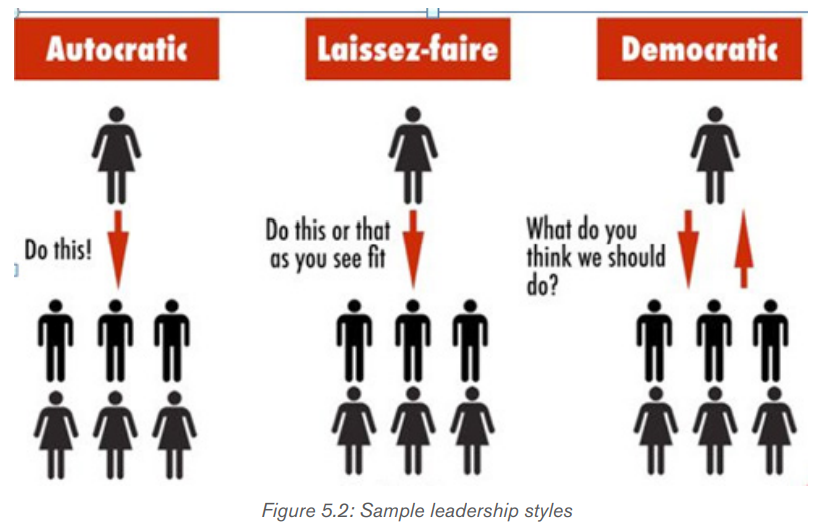
The style you choose will depend on the context in which you are working in,
the people you are working with, their needs and expectations,
whether or not you have a deadline, the task, etc.The following are the most typical leadership styles:
a. The “Autocratic/Task-oriented/Authoritarian” style
• Identifies a problem, considers alternative solutions,
chooses one of them, and then tells followers what they are to do.
• May or may not consider what the group will think or feel about
the decision, but they clearly do not participate in the decision-making.
• Assigns roles.• Relies primarily on his or her own judgment.
b. The “Persuading” style
• Like the “Authoritarian” leader, he/she makes the decisions
without consulting the group. Instead of simply announcing
the decision he or she attempts to persuade the group members
to accept the decision.• Describes how the decision fits everyone’s interests.
c. The “Consulting/ Democratic” style
• Gives the group a chance to influence the decision from the beginning.
• Presents the problem and relevant background information,
and then asks the members for their ideas on how to solve the problem.
• May offer a possible solution for the group members’ reaction.• Selects the solution the members regard as most promising.
d. The “Joining” style:
• Participates in the discussions as “just another” member agreeing
in advance to carry out whatever decision the group makes.
• Encourages group decisions.
• Allows for individual recognition.• Tends to guide, not rule.
e. The transformative style
• Leader identifies the needed change.
• Creates a vision to guide the change through inspiration.• Executes the change with the commitment of the members.
f. Laissez-faire leadership
• The leader makes the subordinates aware of the broad goals
and objectives of the business.
• The subordinates are left free to organize themselves
and make their own decisions.
• The leader totally trusts their employees/team
to perform the job themselves.
• The leader just concentrates on the intellectual/
rational aspect of his work and does not focus
on the management aspect of his work.
• This leadership style works only when the employees are skilled,
loyal, experienced and intellectual.Appropriateness of each leadership style
a. The Authoritarian and persuading styles of leadership are most prevalent:
• In large groups.
• In passive groups.
• In groups, which seldom meet.• At times when a quick decision or deadline must be met.
b. The Consulting style of leadership is most effective and/or prevalent:
• In large groups.
• In motivated groups.• In organized groups.
c. The Joining style of leadership is most prevalent and /or effective:
• In small groups.
• In highly motivated groups.
• In groups that can deal with a less structured environment.
There might be a lot of brainstorming, trying things out
but switching direction as needed, etc.,
• In groups, which have a relatively high need for independence.
• In groups where the members have the necessary knowledge
and experience to deal with the problem.• In groups where the members expect to share in decision-making.
d. The Transformative style of leadership is most effective and/or prevalent:
• In teams with different strengths and weaknesses.
• When you want team members to work through a problem
and arrive at a solution themselves (rather than giving them
the answer or direction straight away).
• When you want to get your team to engage through
providing direction and motivation.
• When you want to get your teams’ respect by being honest,trustworthy, and driven.
Application activity 5.2
Analyze the scenarios below, and determine which leadership style
is more appropriate for the scenario and give reasons to support your choice.
a. You are at the workplace and suddenly the building where
the finished products are stored catches fire.
b. In the finance department, workers are complaining
that the rules and regulations in their department are
not favorable to all and therefore, need to be changed.
c. In your department, as a leader you want to introduce
computers because you believe they will improve on
the efficiency of the workers but they feel computers are not necessary,
as it is a wastage of the company’s money.
d. Recently, there have been changes in government policies that
automatically affect the performance of the business.
You as the managing director are to lead senior management to come up
with strategies to counter the effects of the new policies.
e. At school, all the classrooms are dirty and need to be cleaned.
f. Implementing government programs such as “Umuganda”5.3 Team building

Activity 5.3
1. Explain the meaning of team building
2. Describe the characteristics of a good team5.3.1 Meaning
A team is a group of people working towards a common goal.
Team Building involves the process of enabling the group
f people to reach their goals. It consists of steps like clarification of team goals;
identification of hindrances to goal achievements;
facing the identified challenges and enabling the achievement of the goals.
Team building is the action or process of causing a group of people
to work together effectively as a team, especially by means of activities
and events designed to increase motivation and promote cooperation.
This is a collective term for various types of activities used to enhance
social relations and define roles within teams, often involving collaborative tasks.
The formal definition of team-building includes:
• Aligning around goals
• Building effective working relationships
• Reducing team members’ role ambiguity• Finding solutions to team problems
The effectiveness of team building differs substantially
from one organization to another.
The most effective efforts occur when team members are interdependent,
knowledgeable and experienced
and when organizational leadership activelyestablishes and supports the team.
Effective team building incorporates an awareness
of team objectives. Teams must work to develop goals,
roles and procedures. As a result, team building is usually
associated with increasing task accomplishment,goal meeting, and achievement of results within teams.
Note: The ability to work as part of a team is one of the most
important skills in today’s job market.
Employers are looking for workers who can contribute
their own ideas, but also want people who can work with others
to create and develop projects and plans.
Katzenbach and Smith (1993) list the followingrequirements for building effective teams:
i) It should be small enough in the number of members.
ii) Adequate levels of complementary skills.
iii) Truly meaningful purpose
iv) Specific goal or goals.
v) Established clear approach to the team’s work.
vi) A sense of mutual accountability.vii)Defined appropriate leadership structure.
5.3.2 Characteristics of a good team
• Clear goals: Clear goals are necessary so that all team members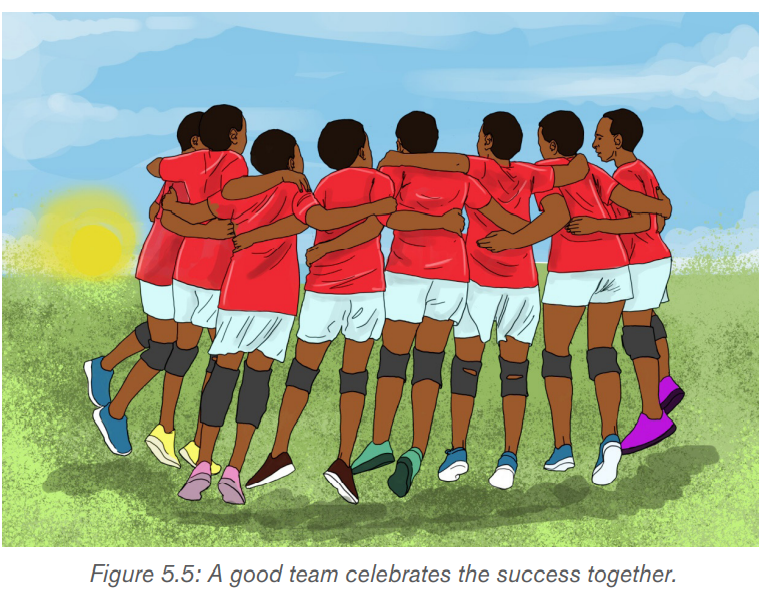
understand the purpose and vision of the team.
• Defined goals: Goals should be defined so as team members
understand their job function for leaders to tap intothe skills and talents of group members.
• Open and clear communication: Effective communication will keep a team
informed and focused. It is important to focus on hearing messagebefore forming our own conclusions.
• Effective decision making: Awareness of various decision-making
methods can help a team member make efficient decisions.Team members should select a method that works best them.
• Balanced participation: Full involvement of team members
is valued and sought. It is important that leaders define what typeof participation they expect from members.
• Valued diversity: Diversity of thinking, idea generating, problem solvingand experiences help to create an effective team.
• Cooperative relationship: Team members need to work together for the good of the team,
and understand that combining the skills of numerous people will producesomething that could not be created alone.
• Participative leadership: A good team is characterizedby shared leadership among team members at various times.
Application activity 5.3
Read the following activity and answer questions that follow.
You are the president of your school business club.
The District Youth leader has advised you that for your club
to win the upcoming competitions, the club should have
an overall impact on the school and community.
Club membership should comprise students from S1 to S6, but S4&5
members are not willing to accept students from other classes.
They claim that the new members will simply enjoy current club achievements
, and they will not bring much since most of the work has been done,
and projects are already running; the club is not united as well.
As the president:
a. What should you do to ensure the club is united?
b. What characteristics are required for the club to be successful?
5.4 Steps for building productive and effective teamsActivity 5.4
Using your own knowledge on team building, explain team building steps/ techniques.
Without team building skills, the manager risks limiting the productivity
of his/her employees to what each member can do on their own,
whereas if he/she fosters team building, he/she can unite teams
around a common goal, which will raise productivity as a result.
The following are five steps to buila productive and effective team:
Step 1: Establish leadership.
If your employees trust your judgment, they will work effectively
even when you are not around. Before you start team building,
you need to develop the right kind of leadership skills.
This doesn’t mean asserting authority, instead tryto foster trust through honesty and transparency.
Step 2: Establish relationships with each of your employees.
A manager tries to learn more about each member of his/her team,
their skillsets, how they are motivated and their likes and dislikes.
This knowledge is invaluable to managers as it allows them to match
each employee’s expertise and competencies to specific problems,which will help increase their productivity and job satisfaction.
Step 3: Build relationships between your employees.
As a team starts to cooperate more, examine the way they work together
and take steps to improve communication, cooperation and trust amongst the team.
If there are any conflicts, try to resolve them amicably.
Listen to both sides of the argument and act as a mediator.
One way to do this is to brainstorm solutions,which helps to empower your employees and may lead to new solutions to the problem.
Step 4: Foster teamwork.
Once relations with and between employees have been established,
it is time to help them work together effectively.
Encourage the team to share information,
both amongst them and within the wider organization.
Also, try to communicate more with the team.
This goes beyond simply holding meetings, and includes
things like being open to suggestions and concerns,
asking about each team member’s work and offering
assistance where necessary, and doing everything
to communicate clearly and honestly with the team.
Step 5: Set ground rules for the team.
Finally, begin officially establishing the team
through creating team values and goals,
as well as evaluating team performance alongside
individual performance. Be sure to include the team
in this process so that they know what is required and agree with it.
Team building is one of the most important responsibilities
a manager has. It isn’t something that can be achieved
in a short time and then forgotten. It is an ongoing organic
process that you will have to facilitate and guide.
Application activity 5.4
As a student representative, you have been challenged
to ensure that all students in your class participate
in a community day. However, most students are saying it their only time
to do private activities and thus have no time.
As a leader, how would you apply the steps for building productive
and effective teams to manage the above challenge?
5.5 Strategies for managing a team
Activity 5.5
Think of a situation at work, school or home where there is a new/
unfamiliar task for everyone to accomplish.
People are required to get themselves organized to accomplish it.
This particular task will need leaders to emerge and assume responsibilities,
manage people and the communication process for the success of the given activity.
Assume you are selected as the leader;
describe some strategies you will use to have the people accomplish the task.
Leaders can employ different strategies
while bringing people to work together and developing teamwork:
• Work with the team to develop a common goal.
• Nurture sense of belonging; focus on
what team members have in common.
• Help team members’ work together
to efficiently solve problems.
• Encourage members to set aside personal goals
and desires for the benefit of the team.
• Treat team members fairly and equally.
• Structure the work of the team in a simple &
logical fashion; distribute work fairly.
• Manage team efficiently so that work proceeds in a timely manner.
• Create an environment that supports
nd rewards openness, creativity, trust, mutual
respect and a commitment to provide high quality services.
• Value everyone’s contribution.
• Encourage discussion.
• Ensure all team members understand that
their ideas and opinions are equally important and relevant.
• Encourage people with different abilitiesand personalities to work together.
• Value everyone’s contribution. Team members have different skills
and experience and so each team member must be given an opportunity
and feel that their contributions are valued.
• Empower team members. Delegating authority and empowering
the team to make decisions is more likely to pull together members
together and work collaboratively to achieve business goals.
• Resolve conflict within the team. Constructive conflict among team members
is a sign of a healthy team. However, unhelpful arguments and
conflict should be tackled for the team to stay focused.
• Celebrate team successes. When the team achieves a milestone or target,
you should encourage team members to celebrate their success together
act as an incentive to reach the next milestone or target.
Application activity 5.5
Mutoni has been voted as a youth representative in one of the sectors in Ngoma district.
In this sector, there are over 100 youths who have been asked by the executive to find
a viable project they can start that can solve the problem of unemployment.
This project will be financed by the sector.
The biggest issue they have however is they don’t agree with each other
on which project they would select. Assuming that you are
Mutoni, as their representative, what team management
strategies can you apply to solve the above given issue?
5.6 Importance of teams in business
Activity 5.6
Referring to your class group activities,
explain the importance of teams in business.
There are numerous advantages of teamwork in business.Some of the genuine advantages are discussed below:
• Division of work and achieving set goals: Teamwork ensures
that there is an equal and fair distribution
of work within the organization.
A fair work distribution ensures that every person
or every working unit executes any task at hand,
with the best possible efficiency.
The division of work also ensures that the work is doneon time and deadlines are not extended hence achievement of set goals.
• Reduction of risk: When the task at hand is executed
with the maximum possible efficiency, there is a reduction in risk.
The best advantage of teamwork in business is that the burden
of failure is borne by all the members of the teamand it does not fall on the shoulders of just one person.
• Subordination of personal interest to organizational interest:
One of the biggest advantages of teamwork is that personal interest
is subordinate to organizational interest.
This ensures that all the team members put in the maximumpossible efforts into their work, thereby ensuring a high quality and timely output.
• Eases work:
Sharing the workload eases burnout.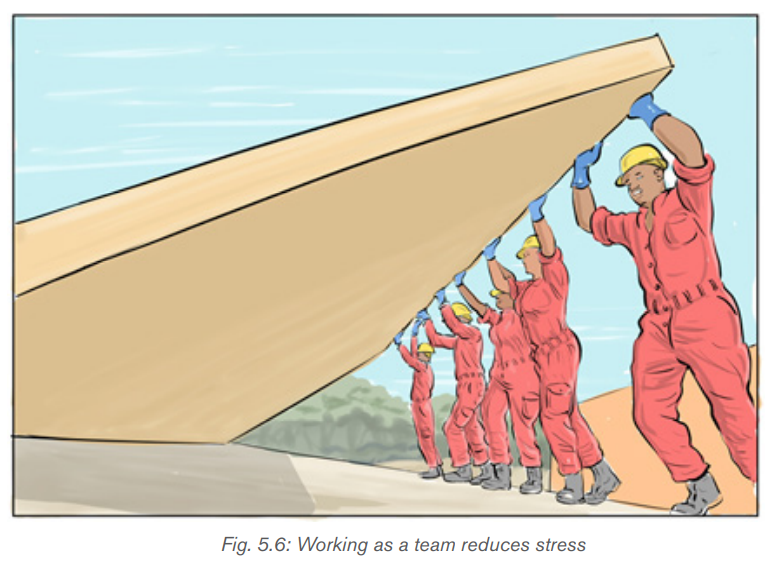
Team members can provide emotional support to each other
because they often understand the demands and stress of
completing the work even better than managers.
This also helps workers to share the tasks according
to their ability differences.
• Easy management of workers: when workers are assigned
tasks in groups, it is easy to delegate some of the managerial
powers to team leader hence easy management of employees.
• Increases team work spirit:
Most modern businesses are structured around teams.
Even those with highly individualized jobs like graphic
design and publishing need active cooperation among
various members of the organization for a final product to emerge.
It is critical then for every member of the organization to understand
the concept of teamwork and to consider his or her job as part of a team effort.
Ways to encourage team spirit in the workplace:
1. Employ the right people
2. Eating lunch together
3. Organize social events
4. Workshops can also be useful
5. Sharing praise and feedback6. Being inclusive
• Quick business growth: Teamwork can be the smartest strategy for growth as
it influences performance results and organizational objectives.
Teamwork makes people share the same goals and responsibilities
for outcomes, namely the common objective of an organization.
It also enhances effectiveness and productivity of a company whichwould gain an organization more profit (Beal, 2003), etc.
Application activity 5.6
Using your college based club example,analyze the advantages of the club working as a team.
Skills Lab Activity -5-
Read and analyse the scenarios
below and answer the questions that follow:
Scenario 1
Mushimiyimana is the leader of an organization that provides
computer services. She has realized that there is a problem with
the way they advertise their business. Sitting at her desk,
she lists some approaches they can take to improve their communications.
She then tells the other employees what they need to do without
asking for anyone else’s ideas.
Scenario 2
Abatoni is the manager of a catering service called Best Bakery.
They have been asked to prepare cakes for an upcoming wedding
of the daughter of a political leader. She decides that coconut
cakes will be the best and calls the staff together to discuss the order.
She informs them of the order and then launches into a speech
about all the advantages of making coconut cake.
Others express an interest in making vanilla cakes
but in the end Abatoni convinces them coconut is best.
Scenario 3
Karamuzi is the owner of a successful auto mechanic workshop.
A customer has brought a vehicle in that has multiple problems.
He asks his team to assess the problems and get back to him
with possible solutions. A few hours later they have a meeting
to discuss what they have found and what they propose.
They have a discussion, Karamuzi gives some advice and the team begins the repairs.
Scenario 4
Habimana runs a tailoring business in town. He has 5 employees.
With an upcoming holiday, they have many orders to fulfill.
Habimana gathers all the employees to get their opinions
on how to best manage the process so they can meet the deadlines.
In the end, they decide together to divide tasks amongst themselves.
Habimana and two others were tasked with cutting and shaping the cloth
while the other tailors would do the sewing. In the end they managedto keep all of their customers satisfied.
1. Describe the leadership styles applied in each of the scenarios
above and give reasons to support your answers.
2. Role-play, justifying how this was the most appropriate style to apply.
3. In your school business club practices, imagine the situation
where your club president has inappropriately dictated the club members
to do something and come up with best advises on how better
he / she could influence the team members to accomplish the tasks.End of unit assessment
1. Read and analyze the following scenarios and decide
which leadership style is depicted:
a. Juliet is the leader of an organization that provides computer services.
She has realized that there is a problem with the way they advertise their business.
Sitting at her desk, she lists some approaches they can take
to improve their communications. She then tells the otheremployees what they need to do without asking for anyone else’s ideas.
b. Jean de Dieu is the owner of a successful auto mechanic workshop.
A customer has brought a vehicle in that has multiple problems.
He asks his team to assess the problems and get back
to him with possible solutions.
A few hours later they have a meeting to discuss
what they have found and what they propose.
They have a discussion, Jean de Dieu gives
some advice and the team begins to repair.
c. Peter runs a tailoring business in town.
He has 5 employees. With an upcoming holiday,
they have many orders to fulfill. Peter gathers
all the employees to get their opinions on how to best manage the process
so they can meet the deadlines.
In the end, they decide together to divide tasks amongst themselves.
Kwesi and two others were tasked with cutting and shaping
the cloth while the other tailors would do the sewing.In the end they managed to keep all of their customers satisfied.
d. Keza is one of the leading members of the community
youth association in a rural area. Following the illness
of several community members, she decided it was necessary
for community members to have better access to potable water.
During weekly youth association meetings, she shared her vision
and got others interested in resolving the problem.
Together they researched different possibilities such as working
with local government offices to mobilize resources to install a borehole
(pipe drilled down to access clean water). During their association meetings,
Keza always recognized the effort individuals were making.
Eventually the youth were able to mobilize the resources
necessary to access clean water.
The youth and the community members were all inspired byher commitment and hard work to make it happen.
2. Sheja is the manager of a catering service called Best Bakery.
They have been asked to prepare cakes for an upcoming
wedding of the daughter of a political leader.
Advise Sheja on how she would motivate her employees to successfully
complete the order in time and reveal which leadership style is suitablefor this scenario.
